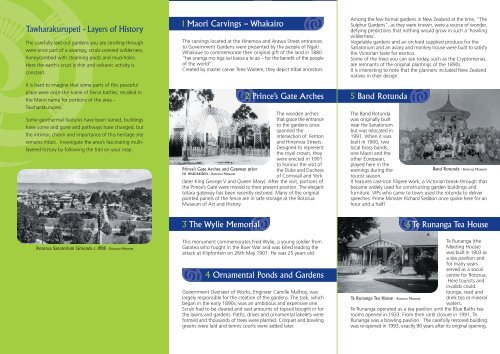Cultural Heritage Trail - Rotorua
Cultural Heritage Trail - Rotorua
Cultural Heritage Trail - Rotorua
You also want an ePaper? Increase the reach of your titles
YUMPU automatically turns print PDFs into web optimized ePapers that Google loves.
Tawharakurupeti - Layers of History<br />
The carefully laid out gardens you are strolling through<br />
were once part of a swampy, scrub-covered wilderness,<br />
honeycombed with steaming pools and mud-holes.<br />
Here the earth’s crust is thin and volcanic activity is<br />
constant.<br />
It is hard to imagine that some parts of this peaceful<br />
place were once the scene of fierce battles, recalled in<br />
the Máori name for portions of the area –<br />
Tawharakurupeti.<br />
Some geothermal features have been tamed, buildings<br />
have come and gone and pathways have changed, but<br />
the intrinsic charm and importance of this heritage site<br />
remains intact. Investigate the area’s fascinating multilayered<br />
history by following the trail on your map.<br />
1 Maori Carvings – Whakairo<br />
The carvings located at the Hinemoa and Arawa Street entrances<br />
to Government Gardens were presented by the people of Ngati<br />
Whakaue to commemorate their original gift of the land in 1880<br />
“hei oranga mo nga iwi katoa a te ao – for the benefit of the people<br />
of the world”.<br />
Created by master carver Tene Waitere, they depict tribal ancestors.<br />
Prince’s Gate Arches and Gateway prior<br />
to restoration - <strong>Rotorua</strong> Museum<br />
2 Prince’s Gate Arches<br />
The wooden arches<br />
that grace the entrance<br />
to the gardens once<br />
spanned the<br />
intersection of Fenton<br />
and Hinemoa Streets.<br />
Designed to represent<br />
the royal crown, they<br />
were erected in 1901<br />
to honour the visit of<br />
the Duke and Duchess<br />
of Cornwall and York<br />
(later King George V and Queen Mary). After the visit, portions of<br />
the Prince’s Gate were moved to their present position. The elegant<br />
totara gateway has been recently restored. Many of the original<br />
painted panels of the fence are in safe storage at the <strong>Rotorua</strong><br />
Museum of Art and History.<br />
Among the few formal gardens in New Zealand at the time, “The<br />
Sulphur Gardens”, as they were known, were a source of wonder,<br />
defying predictions that nothing would grow in such a ‘howling<br />
wilderness’.<br />
Vegetable gardens and an orchard supplied produce for the<br />
Sanatorium and an aviary and monkey house were built to satisfy<br />
the Victorian taste for exotica.<br />
Some of the trees you can see today, such as the Cryptomerias,<br />
are remnants of the original plantings of the 1890s.<br />
It is interesting to note that the planners included New Zealand<br />
natives in their design.<br />
5 Band Rotunda<br />
The Band Rotunda<br />
was originally built<br />
near the Sanatorium<br />
but was relocated in<br />
1991. When it was<br />
built in 1900, two<br />
local brass bands,<br />
one Maori and the<br />
other European,<br />
played here in the<br />
evenings during the<br />
Band Rotunda - <strong>Rotorua</strong> Museum<br />
tourist season.<br />
It features cast-iron filigree work, a Victorian break-through that<br />
became widely used for constructing garden buildings and<br />
furniture. VIPs who came to town used the rotunda to deliver<br />
speeches: Prime Minister Richard Seddon once spoke here for an<br />
hour and a half!<br />
3 The Wylie Memorial<br />
6 Te Runanga Tea House<br />
<strong>Rotorua</strong> Sanatorium Grounds c. 1908 - <strong>Rotorua</strong> Museum<br />
This monument commemorates Fred Wylie, a young soldier from<br />
Galatea who fought in the Boer War and was killed leading the<br />
attack at Klipfontein on 26th May 1901. He was 25 years old.<br />
4 Ornamental Ponds and Gardens<br />
Government Overseer of Works, Engineer Camille Malfroy, was<br />
largely responsible for the creation of the gardens. The task, which<br />
began in the early 1890s, was an ambitious and expensive one.<br />
Scrub had to be cleared and vast amounts of topsoil bought in for<br />
the lawns and gardens. Paths, drives and ornamental lakelets were<br />
formed and thousands of trees were planted. Croquet and bowling<br />
greens were laid and tennis courts were added later.<br />
Te Runanga (the<br />
Meeting House)<br />
was built in 1903 as<br />
a tea pavilion and<br />
for many years<br />
served as a social<br />
centre for <strong>Rotorua</strong>.<br />
Here tourists and<br />
invalids could<br />
lounge, read and<br />
Te Runanga Tea House - <strong>Rotorua</strong> Museum<br />
drink tea or mineral<br />
waters.<br />
Te Runanga operated as a tea pavilion until the Blue Baths tea<br />
rooms opened in 1933. From then until closure in 1991, Te<br />
Runanga was a bowling pavilion. The carefully restored building<br />
was re-opened in 1993, exactly 90 years after its original opening.





